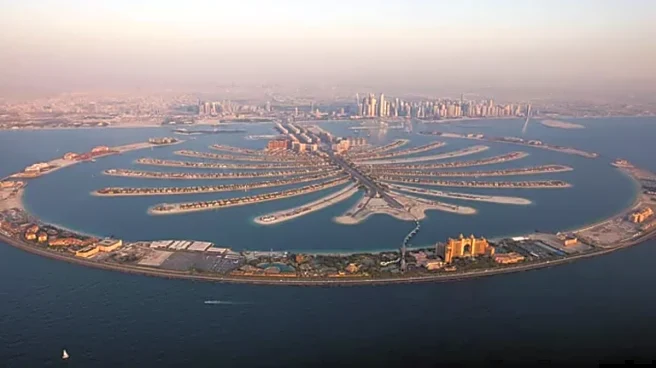From the air, Dubai looks like a mirage turned inside out. The sea curls around shapes that should not exist, a palm tree blooming in the Gulf, a map of the world drawn in sand, a cluster of futuristic
domes glowing offshore. These are not tricks of the light. They are man-made islands, built from ambition, oil money, and an audacious belief that geography is negotiable.
For travellers, these islands have changed how the world looks at luxury, leisure, and even nature itself. Accroding to the Dubai department of Economy and Tourism, the emirate receives millions of visitors annually, with 18.72 million international overnight visitors in 2024. In 2025, the city welcomed 9.88 million international visitors in the first half of the year (January to June). What once was desert now hosts private beaches, underwater restaurants, and neighbourhoods suspended between the sea and sky. Dubai didn’t just expand its tourism; it rewrote its map.
How Did Dubai Turn The Sea and Sand Into A City?
Two decades ago, the idea of creating islands in the middle of the Arabian Gulf sounded absurd. Engineers dredged and relocated over 120 million cubic metres of sand to shape the coastline into the now-iconic Palm Jumeirah, the first of Dubai’s man-made wonders. It was followed by The World Islands, Bluewaters Island, and the still-evolving Palm Jebel Ali.
In 2001, Dubai hit the peak of its infrastructure boom. With its coastline nearly maxed out, property developer Nakheel looked seawards for expansion, a move that would turn the Arabian Gulf into a construction frontier. The plan was audacious: to extend Dubai’s coastline by building entire islands from sand, creating luxury neighbourhoods for a global elite and fuelling a new kind of tourism economy.
Three palm-shaped projects emerged from this vision Palm Jumeirah, Palm Jebel Ali, and Palm Deira designed to be visible from space. Soon after came The World Islands, a scattered cluster resembling a miniature map of the planet. The ambition did not stop there. The Universe and Dubai Waterfront were proposed as the next generation of reclaimed archipelagos, meant to push the boundaries of scale and imagination even further.
The process was monumental. Millions of cubic metres of sand were dredged from the seabed, nearly six nautical miles from the coast, and compacted into form. Rock and limestone were quarried from across the emirate to stabilise the new land. Each palm island was more than a tourist attraction; it was a physical reimagining of Dubai’s geography — proof that its coastline could grow as fast as its ambition.
The Palm Islands
Palm Jumeirah was the first to rise from the sea — and perhaps Dubai’s most defining silhouette. Completed in 2006, it doubled the city’s coastline with a pattern of fronds holding villas, hotels, and resorts, all protected by a crescent-shaped breakwater. That crescent houses Atlantis The Palm, a sprawling hotel complex with its own waterpark and ocean-view suites. Around 10,000 residents now call this man-made island home.
Palm Jebel Ali followed, planned on a grander scale, but stalled when the 2008 global financial crisis hit. Palm Deira envisioned to be eight times the size of Palm Jumeirah — met a similar fate, with only a section rebranded and revived as Deira Islands, now a hub for culture, retail, and high-rise living.
The World Islands
Launched in 2003, The World Islands project was among Dubai’s boldest ideas. From above, its patchwork of islands forms a near-perfect replica of the world map. Each island was intended to represent a country, with private investors free to create their own micro-nations of luxury. Spanning between 14,000 and 42,000 square metres each, the islands became a symbol of ultimate exclusivity.
The economic slowdown of 2008 put much of the project on hold, but a few pockets — including Lebanon Island, The Heart of Europe, and the Floating Seahorse villas — have since evolved into liveable, tourable destinations, complete with European-style promenades and underwater suites.
Bluewaters Island
By 2018, a new competitor entered the picture. Meraas Holdings launched Bluewaters Island, a pedestrian-friendly hub anchored by Ain Dubai, the world’s tallest observation wheel at 820 feet. Though the attraction has paused operations since 2022, the island remains lively with over 200 shops, restaurants, and beach clubs. It is easily accessible by foot via a bridge from Jumeirah Beach Residence, turning a quick stroll into a crosswater escape.
Burj Al Arab
Long before the Palm projects, Dubai had already tested its marine engineering prowess with one of the most recognisable landmarks on Earth — the Burj Al Arab Jumeirah. Completed in 1999, the sail-shaped luxury hotel was built on its own artificial island, supported by 250 underwater columns and reinforced by layers of sand.
Two of its five construction years were spent just creating the island base. Today, it stands at over 1,000 feet nearly as tall as the Empire State Building, featuring a private beach, a helipad that doubles as a tennis court or golf range for special events, and a terrace that juts dramatically into the Gulf.
Why Do These Human-made Islands Attracted Travellers?
Before the islands, Dubai was known for its gold souks and desert safaris. Today, it draws millions to its floating neighbourhoods, where travellers can wake up in a villa shaped like a palm leaf, take a ferry to an island designed to resemble Europe, or dine beneath the sea at Ossiano in Atlantis, The Palm.
Tourism here is no longer about visiting a place; it is about inhabiting a fantasy. Simply put, Dubai gave the global traveller something few destinations could offer: the feeling of being somewhere entirely new, even in a world already mapped by satellites and smartphones.
Standing On Ground That Did Not Exist
For the traveller standing on the breakwater of Palm Jumeirah, the view is hypnotic. The city rises like a crown above the Gulf, and the islands glimmer with curated perfection. Yet what lingers is not just luxury, it is the strange awareness of standing on ground that did not exist twenty years ago.
As dusk falls, the skyline flickers alive and the sea turns molten. The islands no longer feel artificial. They feel inevitable as if Dubai had always been meant to float between the possible and the imagined.
What Can Travellers Actually See And Do On Dubai’s Man-Made Islands?
For all their engineering brilliance, Dubai’s man-made islands were built with travellers in mind. Each one promises a different kind of escape — from family holidays and celebrity-grade dining to design-led stays and record-breaking attractions.
Palm Jumeirah:
The most famous of the trio, Palm Jumeirah is packed with headline destinations — Atlantis The Palm with its vast Aquaventure Waterpark, Nobu’s world-class dining, and The View observation deck perched 240 metres above ground. Travellers can book yacht cruises circling the palm’s fronds, relax at beach clubs like WHITE or FIVE Palm, or check into ultra-luxury stays such as Jumeirah Zabeel Saray and The Royal Atlantis.
The World Islands:
Still partially under development, these islands offer a more secluded and experimental experience. Highlights include Lebanon Island’s private beach club, The Heart of Europe’s floating villas, and underwater suites with coral reef views. It is like stepping into a micro-version of the world — where Monaco meets Maldives under Dubai’s sun.
Bluewaters Island:
A short walk from Jumeirah Beach Residence, Bluewaters pulses with energy. Its centrepiece is Ain Dubai, the world’s tallest observation wheel, surrounded by open-air restaurants, luxury apartments, and the first Madame Tussauds in the Middle East. The island blends leisure with liveability, ideal for travellers who want to stay close to the city buzz but still face the sea.
Deira Islands:
Now evolving into a cultural and lifestyle hub, Deira Islands showcase the more community-focused side of Dubai’s expansion. Visitors can expect art spaces, local markets, and waterfront dining a quieter, more grounded contrast to the Palm’s glamour.
Burj Al Arab:
Technically an island of its own, the sail-shaped Burj Al Arab Jumeirah remains the ultimate symbol of Dubai’s extravagance. Its helipad alone has hosted everything from tennis matches to Formula 1 stunts. Even for those not checking in, a visit for afternoon tea or dinner at Al Muntaha offers a taste of its legendary service and sea views.
How Dubai Changed What The Future of Travel Looks Like?
Dubai has shifted the global travel narrative. It is not selling nostalgia or untouched wilderness; it is selling the future, human-made, meticulously planned, and always one step ahead of imagination.
The islands are not just marvels; they are mirrors reflecting the contradictions of modern travel. Building paradise from scratch came at an environmental cost. Marine ecosystems were disrupted, coastal patterns altered, and sustainability remains a point of contention.
But Dubai thrives on this tension between creation and consequence, between desert realism and oceanic illusion. The city’s defenders argue that such innovation drives progress and positions Dubai as a laboratory for future living. Its critics see a warning about humanity’s obsession with control over nature. Both views coexist beneath the same golden skyline.









/images/ppid_a911dc6a-image-176125042609271672.webp)



